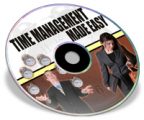Salespage Snapshot:

Table of Contents
Foreword
Chapter 1:
Where Do You Spend Your Time
Chapter 2:
Managing Tasks
Chapter 3:
Planning
Chapter 4:
Goals
Chapter 5:
Tips From The Gurus
Sample Content Preview
Synopsis
While I’ve aimed this material at Smartphone, Pocket PC, and Palm users, the precepts may be applied to desktop/laptop computer architecture and to paper-based planning schemes. In early 2001, I read David Allen’s Getting Things Done (GTD) book and at once started implementing GTD on my Palm. I liked its inspired approach. Then GTD became a major tool for assisting me deal with all the stuff in my life. It let me accomplish this without calling for great concentration. I’ve since blended some of the FC and GTD methodologies. GTD helps me get a lot accomplished, and FC helps my effectiveness.
What You Need To Know
Key Principles
1. A fundamental learning from GTD: run through all of your projects and ascertain next actions for them and arrange Them By context of use (like @PC, @Home, @Desk), so that when your mental energy is too low for you to have an effective mind, you’ve a list of actions you are able to perform anyhow. This easy principle may dramatically better your efficiency and your impact. Orchestrating by context makes use of the age-old wiseness of “Be Where You Are.”
2. Design for every day what you have to get accomplished. The importance of doing this can’t be overemphasized. I’ve worked closely with dozens of senior and mid level people over the years, and understand that they contrive their days and their weeks. Yes, a lot of them suffer the big inflow of e-mails, new work, and too many meetings that a common mobile worker suffers. But they don’t let that dissuade them from their plans (with the exclusion, naturally, of a few rare emerging activities).
3. Utilize the Pareto Principle. Whenever you center your attention on the actions that rank in the top twenty percent in terms of importance, you’ll have an eighty percent payoff on your effort. … If your to-do list has 10 items on it, the two most crucial ones will give you an eighty percent return on your time.
Arranging a Mindsweep
You can’t adequately manage your jobs if you don’t have all of them named. It does no good to have a list of fifty tasks when a hundred others are floating around in your brain and breaking your concentration, particularly when some of those one hundred are more crucial than the fifty that are written down. So, a key to effective task management, is to write all of your tasks down and place them into your planning system (PDA, PC, or paper-based). The finest way I know of to accomplish this is with a Mindsweep: utilizing a tablet, or PC, or PDA, put down everything that springs to mind. It may take you a couple of hours to do this satisfactorily, but you’ll be astonished at how many things you’ll put down that are jobs (or projects) that weren’t in your planning scheme. You ought to do this periodically. You’ll need to go through your inboxes (physical and electronic, home and work) to guarantee you acquire all actions and place them into your system. When you blend this material with what you got from your mindsweep, you ought to have a great listing of everything you need to accomplish.
Keeping it bite-sized (following Actions)
Limit every chore to a solitary activity, the one you have to accomplish next to make progress on an undertaking. Prior to GTD, a common action item in my chore list may have been ‘formulate Home Budget.’ I’d dillydally on it as I recognized those 3 words represented much work. That “chore” wasn’t real a chore at all, but a Project comprising several tasks. So, I’d put it off, time and time again. But today, the beginning single step action item for this project may be critique expenses for the past 2 months. That’s a particular activity that my brain knows I may accomplish in a fairly short time period, so there isn’t as much of a tendency to put it off.
Managing Contexts
If you’ve never altered the categories in your Palm’s To-Do list or Pocket PC Tasks list, you’ll likely determine that there aren’t many and that they’re pretty general. While the stock categories supply a workable way to categorize projects, customizing the categories will help you best manage your tasks.
You ought to always consider how you are able to personalize the categories to work better for you. For instance, you likely wouldn’t want my @Couch class. However, I utilized it as some of my @Home tasks are ones I’ll do only if sitting on my couch (like Mindsweep)you are able to set these classes up directly on your Pocket PC or Palm, but it’s best to go into Outlook and utilize its Master Category tool to arrange the categories. While you’re arranging your fresh categories, you may wish to delete several the existing Master Categories that are built into Outlook, as a lot of them are likely to not be valuable to you.
Prioritizing
Quit prioritizing tasks and begin factoring in your intuition when you make selections on what to work at next (thinking about time available, energy state, context etc.). Individuals who implement the A, B, C priority systems for their tasks fall under the trap of working at only the A and B points, letting additional items fade for long periods, even for jobs that may be done in a matter of minutes of arc.
A few tasks are intrinsically more crucial than others, and you don’t wish to get into a spot where the more crucial work is consistently held hostage to the simpler and less important work. So what do you do? One method of prioritizing while still utilizing GTD is to have a center category. When I utilized it, I’d normally assign 6 or so jobs to this category during my weekly planning session. It doesn’t matter if they’re ones that I’d do @Computer or @Office or @Home, they’d get assigned to this class. The tasks I’d assign to this class would be ones I truly, really wish to have accomplished by the end of the following week.
A different area in which I deviate from “pure GTD” is in the utilization of assigning dates to a few tasks. For instance, if I’ve an crucial meeting for next Thursday, I delegate myself a task of “preparation for Thursday meeting” and give it a begin date of Tuesday and an finish date of Wednesday (so that if I don’t get to it on Tuesday, ascribable to emergent tasks, then I still have Wednesday to do the preparation). I might have many such tasks in a common week. I personally like to have an Agenda View on my Smartphone and Pocket PCs (and Palm), which shows the day’s appointments and chores.
Utilizing the Two-Minute Rule
The Two-Minute Rule has been as helpful to me as any time management construct I’ve come upon in the past thirty years of my business life. The Two-Minute Rule is this: if you’ve an activity that may be done in 2 minutes or less, accomplish it. For instance, if you’ve an item in your in-box that states ‘call Billy Bob about condition of the deal’, accomplish it. Why place an item in your in-box or Tasks list when you are able to simply plow ahead and accomplish it nearly as fast? Although profoundly easy, this is one thing I find I have to work at from time to time.
Synopsis
Weekly planning is a crucial activity that ought to be a habit for every business pro. Disregarding it may cost you in the long-term, and even in the short-term.
Plan It
I’ve a recurring Friday appointment with myself for arranging my weekly planning. Arranging it on a Friday provides me an opportunity to do anything I might have omitted during the week. I’ve discovered that it helps me to have peace and quiet (shut office door), but you might like a little background music.
For mobile workers: If you travel a great deal, you’ll likely wish to have your planning material with you. (You are able to generally keep it all on your PDA or paper planner or combo of both.) I’ve occasionally done a great part of my weekly planning while on an plane flight back home, utilizing a weekly planning checklist on my Pocket PC to lead me (may do with a Palm device, also).
Before you do any literal planning, it’s crucial to do a full review of the week to see if you’ve left out anything. This critique would include going through all of your inboxes, physical besides electronic, to view memos, notes to yourself (including yellow stickies), and anything where you’ve placed info that you have to do something with. If you don’t keep your e-mail inbox empty (I’m guilty on this one), you’ll wish to view all the e-mail that came in during the week to guarantee you haven’t forgotten to flag any you have activity on.
I likewise like to go through my Task list to determine if there are any jobs I meant to complete but didn’t. I likewise check to see if I have to reword any of the jobs to ensure they’re truly action-oriented. After executing the recap, it’s time to get into to analyzing every Active Project to guarantee that you identify a following activity for every one. This is likewise a great time to countercheck that you’ve defined a clear Successful Result for every project. This ought to be followed by viewing each of your Someday and perhaps items to see if there are any that have to become Active Projects (or even wiped out).
The weekly planning session is likewise a fantabulous time to recap your mission and likewise your goals, to see if you’re on target with them and to take action if not.
After I’ve accomplished this, I recap approaching appointments to see if there are any meetings or deadlines I demand to prepare for. Note that it’s a great practice to exhibit project deadlines on your calendar. The way I like to accomplish this is with an all-day appointment.
The last steps in the process are to distinguish Focus Items and to think about scheduling time for the most crucial jobs. You ought to likewise think about allowing time to work on particular projects or to accomplish particular types of work (like @Computer tasks). Ordered and thorough weekly planning may help put you and keep you on top of your game.
Other Details- 1 Article (DOC)
- 1 Ebook (DOCX, PDF), 31 Pages
- 1 Lead Magnet Report (DOC, PDF), 20 Pages
- 1 Autoresponder Email Messages (TXT)
- 1 Salespage (HTML)
- 1 Squeeze Page (HTML)
- Ecover (JPG)
- File Size: 2,867 KB













